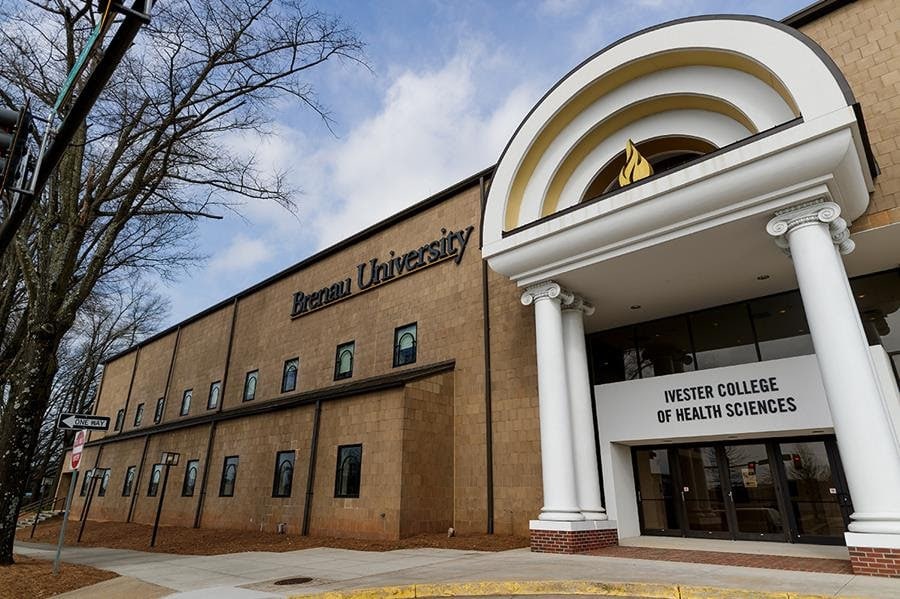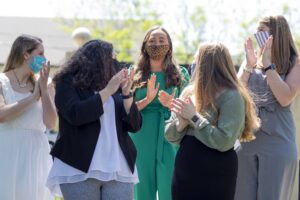
Brenau University’s annual Research Symposium was held virtually on Friday, April 9, and included more than 100 presentations by students and faculty members.
This year’s event featured pre-record presentations, and presenters were on hand to answer questions from audience members. Unlike previous years, this Research Symposium did not have a theme the students had to follow. Instead, they were able to present their ongoing research, many of which included the impacts of COVID-19 on different careers.
With the ability to watch the presentations at any time and from anywhere, nearly 300 people signed up to see students and professors discuss the research they have been working on for the past year. Participants were also able to hear a poetry reading from Tiana Clark as part of the Georgia Poetry Circuit, view poster presentations and take part in an ecocriticism panel.
Micki Waldrop, assistant professor and research and instruction librarian, said the Research Symposium committee began thinking of ways in the fall to make this year’s symposium “comfortable, user-friendly and safe.”
“We decided that using the Canvas classroom and discussion format is something that we are all used to using here at Brenau,” Waldrop said. “It gives us one added benefit that Research Symposiums have not given in the past, which is that we are allowed to keep the classrooms open. That way, if someone misses a session because they’re going to another one, they can always log back in and watch all the presentations in their own time.”
The symposium began with a discussion on diversity, equality and inclusion from Amanda Lammers and Margie Gill.
Lammers updated the community on what Brenau’s Working Group on Diversity, Equality and Inclusion — which she and Gill co-chair — has been doing recently, including continuing conversations on issues to help better serve Brenau students, faculty, staff and alumni and making curriculum assessments and pedagogies more diverse.
“I think our committee is very much like a duck,” Lammers said. “You see us on the surface, and it looks like we’re cruising around. But underneath, there’s a lot of work going on and a lot of things happening that the community at large might not necessarily see, such as recommending racial equity for each segment at the university. We are doing a lot of good work on campus, and we look forward to doing much more.”
During her presentation, Gill discussed how people perceive others due to the color of their skin and how that can be changed by educating ourselves.
“We hold our own views, stereotypes, prejudices and biases about people until we get to know them,” Gill said. “When we allow these perceptions and biases, whether they’re conscious or unconscious, to control our worldview, we contribute to perpetuating oppressions and we contribute to growing social concerns.”
Senior acting major Olivia Eafano presented on the impacts of COVID on the performing arts. Since many theaters had to shut down, including on Broadway, the performing arts have faced financial burdens. Eafano showed a graph with information from the Bureau of Labor in California that shows there was a 44% decrease in employment from February to September 2020 in the arts, entertainment and recreation fields.
Eafano said that, while some productions have been able to move virtually for the time being, the experience is very different from viewing in-person. For example, with in-person theater experiences, the audience is more focused. When viewing at home, the audience could be distracted while watching the performance. During her research, she found that theaters in Atlanta, such as the Alliance Theatre, are enhancing safety procedures to be able to open for audiences. Some procedures include requiring masks, additional sanitizing stations and mobile ticketing.
Morgan Cochran, a student in the physical therapy doctorate program, worked with Karen Burgbacher, assistant professor of physical therapy, on a case about stroke.
The patient they studied was a 68-year-old male who was 20 years post-stroke. The program Cochran designed was supposed to take place in person over three months but was interrupted due to COVID-19. Cochran then faced problems including the patient having limited access to technology for telehealth. She said their sessions had to be moved to over the phone, which was difficult because she could not see if the patient was doing the exercises correctly, his reactions or the layout of his house.
While the study started out being about how depression would impact the compliance of a client who was post-stroke, it eventually ended up including the telehealth and COVID factor as well. Cochran found that outside factors due to COVID had an impact on her study involving mental health. Telehealth options are important, but she found that some patients do not have those options and plans have to be adjusted to better help the patient succeed.
Waldrop said that the Research Symposium committee received positive feedback from participants who enjoyed being able to return to see other presentations they would have missed during a traditional symposium format.
“I would love to continue the tradition of putting some aspects of the symposium online,” she said. “I think this gave us an opportunity to reach farther across the Brenau community and welcome students and faculty that are housed at places other than the Gainesville area.”
The Research Symposium presentations can be viewed online.

